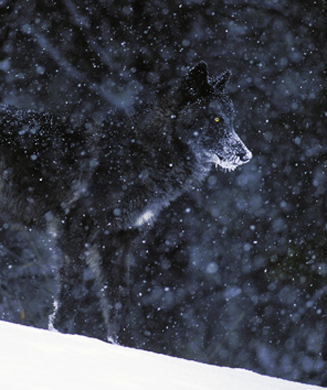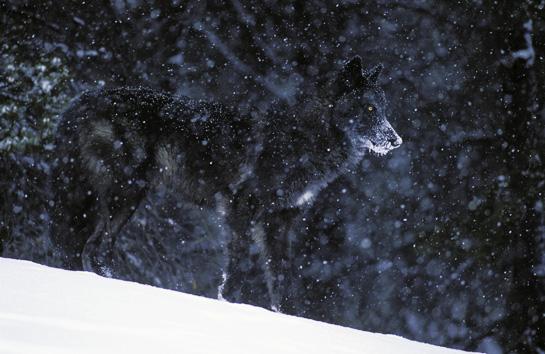
Wolves make their living in the most remote places on the planet. They’re big, tough, and crazy smart. With few exceptions, almost every wolf taken during recently opened seasons in Idaho and Montana has been killed incidentally by a hunter who happened to have a wolf tag in a pocket when he was out hunting something else.
Only a handful of hunters in North America can claim to be expert at consistently taking wolves without the aid of traps or a pack of hounds. Here, three of the best give the inside scoop on how you can better stack the odds in your favor this season.
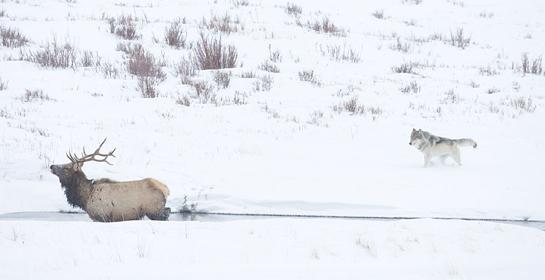
**
DISTRESS CALLS**
In the province of Alberta, Canada, wolf tags are cheap, the season is long, and the bag limits are unlimited. Brad Fenson, a habitat development coordinator for the Alberta Fish & Game Association, says that he usually sees at least one wolf each hunting season.
“Most of the time,” he says, “I see them coming right in when I’m trying to call something else.”
Fenson has hunted all over the Canadian Far North and has seen just about every method used to consistently lure wolves into rifle range. But for sheer excitement, he ranks predator calling as the most challenging and exhilarating tactic.
“A couple of years ago, in northern Alberta, I was trying to call moose with a partner,” he recalls. “We were having trouble with wolves all week. They would come in and start howling. It really shut us down.”
Fenson and his partner decided to turn the tables on what turned out to be a pack of 12 animals. Setting up with a crosswind on the edge of a frozen lake, Fenson hit the cow call, and a big, black alpha male soon appeared on the far bank less than 70 yards away.
“When we shot, the rest of the pack had no idea what had happened,” he says. “They started running back and forth in front of us and we shot five of them, some as close as 10 yards.”
The best advice for calling wolves is to not give up too soon on a stand location where you’ve consistently located sign.
“Wolves tend to run a circuit to work their territory,” he says. “It might take the pack days to return to the same area, but if you can call day after day in a place where you never fail to find tracks, eventually those animals will be in a position where you can call them.”
While Fenson has found that wolves will respond to a moose or elk call at almost any time of day, he prefers to hunt “the shoulder hours”–early morning and just before dark. In areas where wolves are preying on elk and moose, a cow elk bleat and a moose calf bawl are the only sounds you need.
“I’ll always set up on the edge of an opening” he says, “like a small meadow or a frozen lake where I can see at least 100 yards. You want good visibility, and I always prefer a steady crosswind to help avoid detection.”
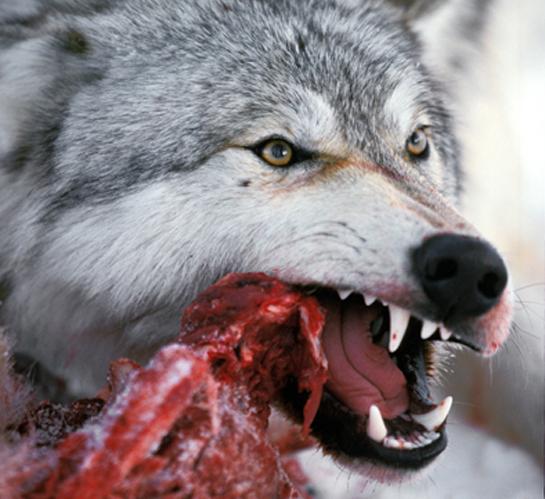
**
BAITING**
Wisconsin and Minnesota were hammering out the details for the first wolf hunts to be held in those states, one of the biggest provisions under scrutiny was whether or not hunters would be allowed to use bait.
American hunters are familiar with traditional techniques of baiting. It’s effective and–when talking about hunting bears–sometimes it’s the only practical method. But according to Ontario’s Peter Martin, the standard technique that requires a hunter to patiently wait out the daylight hours in a stand overlooking the bait just doesn’t work for wolves.
“For baiting to work,” says Martin, “you really don’t want to be set up too close to an active bait site.”
Martin admits this probably sounds counterintuitive. But few can argue with his 20-year track record of getting hunters that once-in-a-lifetime crack at a wolf. The owner of Kapriver Retrievers & Outfitters (kapriveroutfitters.ca) is a wolf-baiting master with hundreds of happy clients.
“We’ve tried to sit hunters in full view of the bait, as far as 250 to 300 yards across a frozen lake,” he says. “Those hunters would almost always get action. They’d see and hear wolves, but only one hunter a year would ever manage to connect.”
Five years ago, Martin decided to try something new.
“We had a really hot bait and decided to set a hunter in a ground blind overlooking two bush roads that the wolves crossed on their way to the bait. The stand was more than 300 yards away from the bait site through the woods. We dropped him off and within 30 minutes he shot a wolf.”
Since then, Martin has had 25 hunters kill wolves using this method. Martin builds a ground blind anywhere from a quarter to a half mile away from the bait. “The closer a wolf gets to a bait, the more he’s on guard,” says Martin. “I use ground blinds because they’re simple to conceal, quiet, and easier for a hunter to slip in and out of.”
“The best time to be in the blind is when a bait has just been hit and there’s still plenty left on the ground,” he says. “That’s when you want to get into position as soon as possible. If you freshen up the site, don’t worry about scent. It doesn’t seem to bother them.”

**
HOWLING**
Given how much hunters use bugling for elk and grunting for deer, it’s hard to imagine a time when predator hunters didn’t use howling to draw coyotes into gun range. One of the masters of this technique is Herb Brusman of Long Creek, Oregon. After 23 years as a government trapper–and using the first, handcrafted cow horn howler he made in the early 1960s as a prototype–Brusman founded Herbs Howlers in 1984 (herbshowlers.com).
Brusman’s howler, and the language he used to describe the sounds coyotes make, helped create a legion of howling experts and an entire industry of calls, books, and instructional DVDs. Brusman is best known for his coyote-calling expertise. But for the last 12 years, he has also worked to perfect a technique for howling in wolves that still works for him today.
“Three years ago, I howled in my best wolf ever,” says Brusman, now 76. “He was a big male, with 3-inch-long fur and white legs that fade into his body, which is all gray.”
Brusman can only guess at the number of coyotes he’s called into gun range–maybe 5,000. But he remembers every wolf, at least one every year since 1990. That’s when he traveled to Calgary, Alberta, to learn wolf vocalizations from renowned Canadian wolf caller Gerd Jost.
“The biggest difference between coyote and wolf vocalizations is that the wolf doesn’t do as much barking and his howl is a deeper, longer, and more melodious sound,” says Brusman.
Wolves are smarter and more territorial than coyotes, according to Brusman, but the way they respond to a howler and the basic calling sequence a hunter uses is familiar to any predator hunter who can tell the difference between a lonesome howl, a challenge bark, and a pup ki-yi.
“With the right sounding call, a good coyote hunter can call in a wolf,” he says. “But a wolf’s territory is five times bigger than a coyote’s, which means the biggest problem in calling them is the time you have to put in to locate the roaming pack.”
A wolf will respond to howling at roughly the same distance as a coyote. This could be up to a mile or more if your calls are convincing and the situation is ideal. But it’s always better to get as close as you can, as noiselessly as possible. If you alert the animal to your presence, the hunt is over.
“I also limit my wolf calling to dawn or right before dark,” says Brusman, who likes to set up facing the wind with some sort of landscape feature at his back to prevent an incoming animal from circling downwind.
In addition to a full line of custom coyote howlers, Brusman offers a cow horn wolf howler with an instructional book for $95.
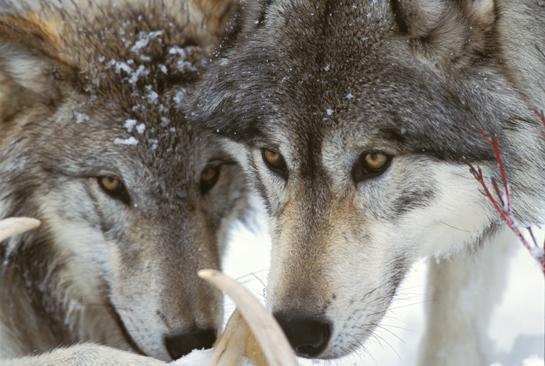
**
WHERE TO HUNT**
Only 5 states in the Lower 48 allow wolf hunting this year, and the only thing tougher than taking a wolf in one of these places is wading through the differing laws regulating how and when they can be hunted. Complicating matters further is the threat of last-minute lawsuits aimed at blocking the hunts. Below are some basic guidelines. Consult the websites of each state agency for details on any changes to season dates and regulations.
Idaho
Last year, during Idaho’s 10-month wolf season, hunters and trappers took a total of 379 wolves out of an estimated population of between 700 and 1,000. In 2012, Idaho wolf hunting opened on July 1 in the Panhandle Zone, on private land only. The rest of the zone and the remainder of the state opened to wolf hunting on August 1, and all but the Lolo and Selway zones will close on March 31, 2013. While most Idaho wolf hunting zones have a cap of two wolves per hunter, per year, the Middle Fork, Dworshak-Elk City, Palouse-Hells Canyon, Lolo, Selway, and Panhandle zones currently allow hunters to kill five wolves per calendar year. In July 2012, the Idaho Fish and Game Commission approved the limited use of legally salvaged wildlife as bait for hunting and trapping wolves in the Panhandle wolf management zone. Tags are available at fish and game offices, license vendors, and online at fishandgame.idaho.gov.
Minnesota
Minnesota’s first wolf season, which was scheduled to begin November 3, 2012, was split into two parts: an early wolf hunting season coinciding with firearms deer hunting, and a late wolf hunting and trapping season after the firearms deer season. The application deadline is past. A total of 6,000 licenses were offered, with 3,600 available in the early season and 2,400 in the late season. Late-season licenses were further split between hunting and trapping, with a minimum of 600 reserved for trappers. The target harvest has been set at 400 wolves for both seasons combined. As is the case in Wisconsin, last-minute changes to seasons and regulations are possible. Go to dnr.state.mn.us for more information.
Montana
Last season Montana hunters took only 166 wolves, failing to reach the quota of 220. The wolf population in Montana has grown so dramatically–it’s estimated at roughly 650 animals statewide–that wildlife officials did away with a statewide kill limit for 2012-13 and nearly doubled the length of the season. The newly expanded season began September 1, 2012, and runs through the end of February 2013. Like Idaho, Montana makes it very easy for hunters to go after wolves. Licenses are available over-the-counter. The cost for resident wolf-hunting tags was set at $19. The nonresident fee was $350. At this writing, it’s illegal to bait or use electronic calls (fwp.mt.gov).
Wisconsin
Wisconsin’s first wolf hunting and trapping season was scheduled to kick off October 15 and continue until February 28, 2013. Wisconsin has an estimated wolf population of 800 animals, and only 200 can be killed in the four-month hunt. At this writing, legal methods of hunting wolves included night hunting and the use of bait. The application deadline is past. In 2012, roughly 20,000 people applied for just 1,160 non-tribal hunting and trapping permits. Hunters unsuccessful in the random drawing were awarded a preference point. The application cost was $10. License fee was $100 for residents; $500 for nonresidents. Check out the Wisconsin Department of Natural Resources website (dnr.wi.gov) for more information.
Wyoming
Licenses for Wyoming’s first-ever regulated wolf hunt went on sale in September 2012. The cost was $18 for residents, $180 for nonresidents. Wyoming set a statewide quota of 52 animals, with an unlimited number of licenses available until the end of 2012 or until each of the state’s 12 wolf hunting units reached its quota. At the end of December 2011, there were an estimated 328 wolves in Wyoming, with 48 packs and 27 breeding pairs. This included 224 wolves, 36 packs, and 19 breeding pairs outside Yellowstone National Park. Hunting began on October 1, 2012, and was confined to an area that includes 15 percent of northwest Wyoming and most of Teton County (wgfd.wyo
.gov/web20112/home.aspx).
